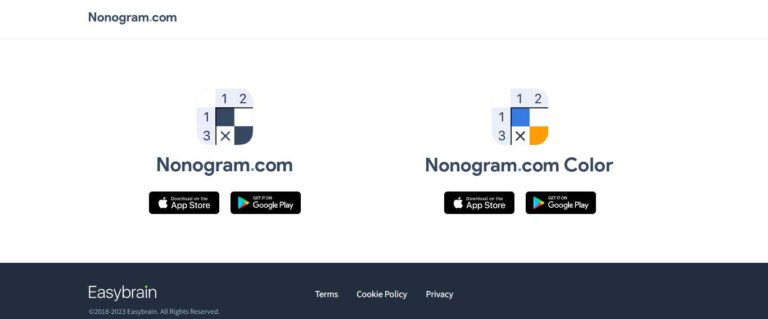One of the oldest and most intriguing puzzles is the nonogram. Cross numbers, griddlers, Hanjie, and image crosses are other names for nonograms. This puzzle game was first developed in Japan.
You undoubtedly have a lot of questions about nonograms in your head. What exactly is a nonogram? Why would you play it? Let’s find out, as we discuss these and much more in this article.
What is a nonogram puzzle?
Nonograms are grid-based number puzzles that are resolved by filling in the grid’s squares as per the guidelines. When the player has finished coloring, they will receive an image. It can be any image, including those of an animal or a flower, is acceptable.
Indeed, working through a nonogram puzzle is calming and entertaining. Hence, pick a nonogram if you’re looking for a game to keep your mind in good shape.
Important things to remember about nonograms
- Every nonogram puzzle is perfectly rational. There is no room for guesswork.
- In a nonogram puzzle, the numbers in a row or column denote how the filled-in cells are arranged. Each group must be separated by at least one cell. Make it a habit to cross out the gaps that are the smallest possible size.
- Finding a solid starting point is crucial when attempting to solve a nonogram puzzle because everything else will usually follow.
- Don’t make assumptions if you believe you have identified the picture in a nonogram puzzle before finishing it. Perhaps you’ll find a few nasty little surprises there!
- There is only one conceivable configuration of cells in a row or column if the sum of the numbers in that column or row plus the number of numbers less than 1 is equal to the height or width of the nonogram puzzle.
- Fill in the whole thing immediately if a row or column has a single number the same size as the puzzle!
- When solving a nonogram puzzle with a single huge number, count in that number from both sides to identify the cells that must be taken. Fill in the space between them after that.
How to solve nonograms
- Begin with everything and nothing. The lines with 0 cells or all cells to be filled are the first solution to any nonogram puzzle.
- Almost complete lines. A second key is a line whose numbers add up to (line length minus the number of breakpoints), which indicates a nearly full line with some breakpoints inside (this means that, the numbers on the line are filled with one break point between one another). An illustration is an (11 3) for a 15-cell line.
- Shadow trick. A line couldn’t always be solved entirely. Thus, getting the line solved as accurately as possible is crucial. The center cells of the line are unquestionably filled symmetrically, suggesting that a single large number there could be the solution.
If one of the cells is already occupied, the procedure might also be applied to lesser numbers. For instance, in this line, the second cell is already filled, and as there is only one in the line, the following three cells are likewise likely to be filled. Nevertheless, because there is one ambiguous space, the following cells are unquestionably empty. (Repeat the above approach, supposing it to be an excerpt from a long line.)
- A two-shadow trick. This method, which is a variation of the one before it, is effective when two numbers are on the line, one of which is noticeably larger. First, try to “get rid” of the larger number; “Think” that the smaller number is stuck on the border end; then, temporarily mark an X next to it; next, use the shadow trick on the larger number. Then, you might be able to do the same for the lesser number (though not necessarily).
- The image’s border. This approach is more of a guessing technique than a true solution; if one of the edge lines has several consecutive (1)s, it is likely that they are filled, creating a pixel “border” in the solved artwork.
Tips to help you solve nonogram like a pro
Here are tips that can help you solve your nonogram puzzles faster and make you enjoy them more.
- Avoid concentrating more on the block colors.
The picture cross puzzle blocks often come in various colors, such as black, white, or grey. The color of the blocks shouldn’t be more important to you because it doesn’t matter. The only thing that counts is how many times you can match the numbers on the side using repeated blocks. Thus, ignore any blocks of various hues that you encounter.
- Concentrate on the empty spaces
When you’ve finished solving it, you’ll discover that a puzzle has numbered blocks and one or more empty blocks. For instance, if you need to complete a 10-puzzle with ten blocks per horizontal line and ten blocks per vertical line, you won’t have any room.
- Practice! Practice! Practice!
The only way to master puzzle-solving is to practice more. After all, perfection comes with practice. Keep in mind that you could occasionally get stranded in a Nonogram. This is because moving on to the next level can be difficult. This is because certain levels are quite difficult. So, you must practice frequently. Thankfully, many internet resources, including books and articles, can teach you how to play picture crosses like an expert. And the best part is that they are readily available online.
Final thoughts
Nonogram, also known as picture cross or picross, is a fun game that can keep you glued to your mobile device for such a long time. It even becomes more enjoyable if you understand the rules of the game and what it entails. We hope that you can use the tips and tricks discussed in this article to help you solve your picture cross or nonogram like an expert.

0 Comments